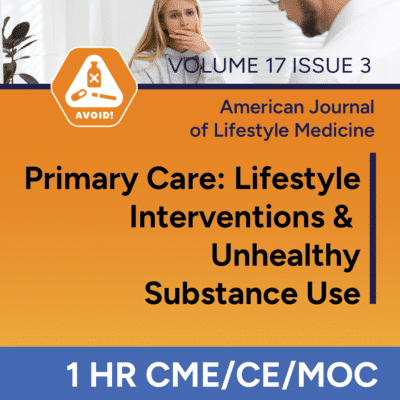
Learning Objectives:
- Identify the prevalence of substance use disorder
- List risk factors that increase the risk of unhealthy substance use
- Describe ways to help improve unhealthy substance use treatment
- Identify benefits of incorporating addiction medicine care into the primary care setting

“Unhealthy substance use continues to be an ongoing epidemic, especially on the heels of the COVID-19 pandemic. The goal of this CME is to educate and encourage physicians to broaden their approach to identifying and managing substance use disorders in all settings including primary care.”
Primary Care at the Intersection of Lifestyle Interventions and Unhealthy Substance Use
Primary care physicians are well-positioned to integrate lifestyle interventions into the management of patients with unhealthy substance use, who may also have mental and physical chronic health comorbidities. However, the COVID-19 pandemic exacerbated the U.S.’s poor state of health, revealing that its current approach to chronic disease management is neither effective nor sustainable.
Today’s full spectrum comprehensive care model requires an expanded toolkit. Lifestyle interventions broaden current treatment approaches and may enhance Addiction Medicine care. Primary care providers have the potential to have the greatest impact on unhealthy substance use care because they are experts in chronic disease management and their frontline accessibility minimizes healthcare barriers. Individuals with unhealthy substance use are at an increased risk of chronic physical conditions.
Incorporating lifestyle interventions with unhealthy substance use care at every level of medicine, from medical school through practice, normalizes both as part of the standard care of medicine and will drive evidence-based best practices to support patients through prevention, treatment, and reversal of chronic diseases.
This learning activity consists of one AJLM article and one quiz.
Duration: 1 hour
Assessment and Measurement: A score of 80% or higher on the quiz is required to pass the learning activity.
Specifications: This course can be viewed on desktop, tablet or mobile device.
Term of Approval: July 1, 2023 – June 30, 2026
Participant User Agreement (Terms of Use and Copyright): Before registering for a Continuing Education/Continuing Medical Education Course (“Training”) for the first time, carefully review the following conditions of usage at https://lifestylemedicine.org/terms-of-use-and-copyright-cme-ce/.
Registering for an American College of Lifestyle Medicine Course indicates your acceptance of the Participant User Agreement and its terms and conditions.
Enrollment: Access to online material is granted through the term of approval which ends June 30, 2026.
Accreditation Statement:
In support of improving patient care, Rush University Medical Center is jointly accredited by the Accreditation Council for Continuing Medical Education (ACCME), the Accreditation Council for Pharmacy Education (ACPE), and the American Nurses Credentialing Center (ANCC), to provide continuing education for the healthcare team.
Designation Statement:
For Medicine: Rush University Medical Center designates enduring material for a maximum of 1.00 AMA PRA Category 1 Credit(s)™. Physicians should claim only credit commensurate with the extent of their participation in the activity.
For Nursing: Rush University Medical Center designates this enduring material for a maximum of 1.00 nursing contact hour(s).
For Pharmacy: Rush University Medical Center designates this knowledge-based enduring material for a maximum of 1.00 contact hour(s) for pharmacists.
For Psychologists: Rush University Medical Center designates this enduring material for 1.00 CE credits in psychology.
For Dietitians: This enduring material has been approved by the Commission on Dietetic Registration for 1.00 CPEUs.
For Social Work: As a Jointly Accredited Organization, Rush University Medical Center is approved to offer social work continuing education buy the Association of Social Work Boards (ASWB) Approved continuing education (ACE) program. Organizations, not individual courses, are approved under this program. Regulatory boards are the final authority on courses accepted for continuing education credit. Social workers completing this course receive 1.00 general continuing education credits.
For physical therapy or occupational therapy: Rush University is an approved provider for physical therapy/occupational therapy by the Illinois Department of Professional Regulation. Rush University designates this enduring material for a maximum of 1.00 continuing education credits for physical therapists/ occupational therapists.
ABLM MOC: The American Board of Lifestyle Medicine has approved 1.0 maintenance of certification credits for this learning activity.
Disclosure Statement:
As a provider of continuing education, Rush University Medical Center asks everyone who has the ability to control or influence the content of an educational activity to disclose information about all of their financial relationships with ineligible companies within the prior 24 months. There is no minimum financial threshold; individuals must disclose all financial relationships, regardless of the amount, with ineligible companies. Individuals must disclose regardless of their view of the relevance of the relationship to the education. Mechanisms are in place to identify and mitigate any potential conflicts of interest prior to the start of the activity. All information disclosed must be shared with the participants/learners prior to the start of the educational activity.
Unapproved Uses of Drugs/Devices: In accordance with requirements of the FDA, the audience is advised that information presented in this continuing medical education activity may contain references to unlabeled or unapproved uses of drugs or devices. Please refer to the FDA approved package insert for each drug/device for full prescribing/utilization information.
Individuals in control of content for this activity have no relevant financial relationships with ineligible companies.
